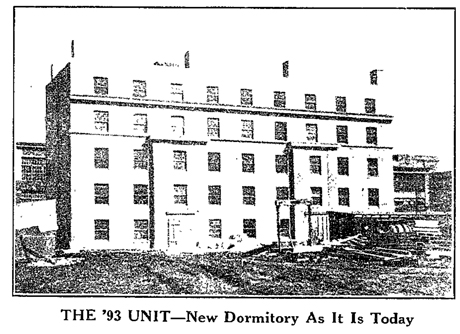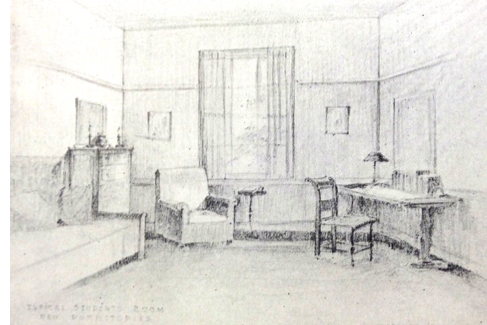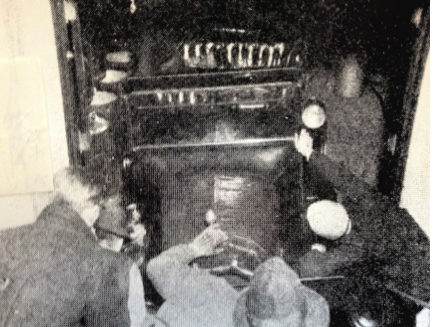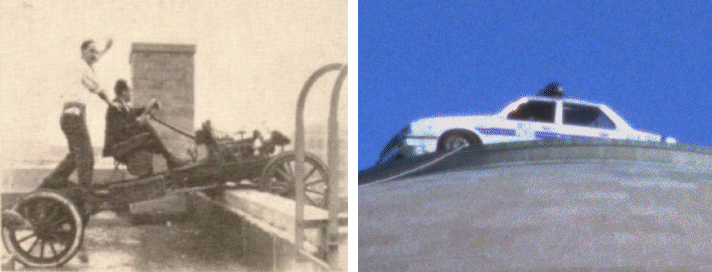Hardk0re: The Twinned Rise of East Campus and the Hacking Ethos (Guest Entry by Danny Ben-David ’15) by Lydia K. '14, MEng '16
How’d that get on the roof?!
Danny Ben-David ’15 is a physics major, East Campus historian, and creator of the amazingly useful CourseRoad (along with TeXcha, a LaTeX-based CAPTCHA, and the super PAC Why Not ZoidPAC?, of which he is President and Grand Poobah and which preceded Stephen Colbert’s super PAC army). I met him on 4th West last semester while tooling on a 6.046 p-set. This is his final paper for STS.050 (The History of MIT), about the founding of MIT’s second dorm, East Campus, and the inauguration of the hacking culture that closely and inevitably followed. Back then EC consisted of only the Bemis section of the east parallel (the west parallel and the other two thirds of the east parallel were built later) and was called the ’93 Dormitory, the East Campus-Senior Haus water war involved kerosene, and things were in general much more hardk0re.

East Campus in its original manifestation in 1924.
The Massachusetts Institute of Technology goes to great lengths to advertise itself as a place not only of rigorous academics, but of multifaceted culture as well. In a given campus tour, time is split equally between covering the assorted classroom and research opportunities offered, and explaining the hundreds of clubs and student activities, along with dining and housing options. However, this was not always the case. In MIT’s early decades, the fledgling Institute lacked both space and capital to expand its underdeveloped social life. Several visionary administrators saw that the introduction of dormitories would allow for the undergraduate population to share their ideas and passions more quickly and effectively than before. The move to Cambridge allowed for the construction of the first dorms in 1916, followed by further dorm expansions in the 1920s and 30s. It was clear that the student body’s activities needed an engineering angle to them, and so the dorms were built with the residents’ passions in mind. What those leaders could not have possibly foreseen was the rest of the student life equation: how, thanks to MIT’s flagship educational approach, the standard practical joking which permeated most college dorms would take on an entirely new level of technicality—the rise of the first hackers. As eloquently described by the Story Jack in MIT’s homegrown musical Hack, Punt, Tool, “hackers are anonymous technological pranksters, engineers inspired to intervene with the everyday monotony.” Their culture, mystified over generations of institutional memory, has become an inseparable part of the MIT identity—and the roots of these traditions can be traced back to the early student life of MIT’s dormitories. In particular, the modern dormitory of East Campus began its life under a different name, the ’93 Dormitory, opening for business in 1924; its introduction to and influence on campus life allowed a critical mass of students to take on their projects and jumpstart the proud tradition of MIT hacking culture.
The Institute’s need for dormitories was evident well before the Cambridge campus’ construction. At the turn of the century, a still-young-but-growing MIT looked at its student life and found it lacking. Here, the greatest young minds were being brought under the single ideological roof of MIT, and yet their interactions were restricted to the academic and professional. The students were trained and skilled—certainly living up to the Mens et Manus motto—but the element of camaraderie was noticeably absent from the campus atmosphere. In the 1901 President’s Report, President Pritchett discusses work on completing the new gymnasium on Boylston Street, the Walker Memorial Building. Pritchett writes:
[Walker] as it is planned contemplates not simply a gymnasium, not simply a building for physical culture, […] but it is to afford as well a place which shall be the social center of student life. No need is more urgently felt amongst the students of the Institute than that of closer contact with each other and with men from outside. The very fact that students do not live in dormitories, but in isolated houses, gives less opportunity to cultivate the social side.
Pritchett saw clearly that by having communal spaces and co-located housing, students would end up interacting, an activity which would no longer seem as foreign as it did at the time. The gym was completed shortly thereafter, but the question of dormitories remained. The problems were twofold: money was tight and Boston was crowded. MIT lacked the space and cash flow to move its students into a single living space adjacent to the Boston campus; trying to solve this problem, the Institute even considered constructing dormitories on a site in Brookline, “for the purpose of bringing men together on a democratic plan.”
Finally, as plans solidified to relocate across the river, it became clear that centralized student living spaces would finally have room to exist, and wholesome residence-based culture would begin to root itself after the move to Cambridge. President Maclaurin, like Pritchett before him, was excited about the upcoming dormitories, referring to their absence on the soon-to-be-former campus as “one of the most serious defects of the Institute.” The Faculty Houses (now referred to as Senior House, collectively) opened with the new campus, featuring accommodations for 170 students across four houses, with the outer two houses offered to fraternities for residency. For a while, this worked well to alleviate the housing pressures; however, a new campus meant more space to spread out, and the Faculty Houses lacked the capacity to match the expansion in undergraduate enrollment. The renewed cries for additional living spaces began soon after.
Despite an intense desire to get dorm construction underway, the financial burden remained: word was passed down from the MIT Treasurer stating that the Institute simply could not cover the cost of the dorm on its own. In the 1920 President’s Report, Dean Alfred Burton fiercely advocates for the cause, including an argument based on the still-fresh memories of fighting a global influenza epidemic the prior year: “A great many of our students are this year living under conditions which are not conducive to either health or study.” Faculty and alumni alike met and determined that they did want these dormitories, but funding sources were simply not there. From where could this capital arise? The source arrived on MIT’s campus, at the 30th reunion party for the Class of 1893. The Class of ’93 had a nickname: “The Millionaire Class,” due to the existence of at least half-a-dozen millionaires among their ranks. After some discussion, the class approached President Stratton offering $100,000 ($1.4 million, adjusting for inflation) if groundbreaking began on the new dormitories by September of that year. The reunion coincided with the graduation of the class of 1923, and so by the time students returned for classes in late September, work on the Class of 1893 Dormitory was well underway.

Bosworth’s sketch of a typical ’93 dorm room.
At most institutions, campus construction would be mentioned in the school publications, but most likely while describing the future purpose of the facilities, and not much beyond that. At MIT, the campus newspaper The Tech and the alumni magazine The Technology Review each went to great lengths to describe the upcoming dormitories in excruciating detail. Seeing how “most Tech students desire single rooms, the new dormitory has a great preponderance of single rooms,” writes Technology Review—a heartening display of the Institute taking student opinion and preference into account for its decision-making. The radiator is described not only as a temperature-control device, but as a multi-faceted tool at the disposal of the resident: “it heats the room, dries the towels, and humidifies the air. (The character of the humidification, depending as it does so much upon the personal equation of the occupant of the room, is not guaranteed in advance by the engineers.)” Further realizing the technology-laden nature of the student body, the decision is made to outfit each room with an outlet to a telephone line, a highly unusual move. Finally, there is much discussion on the reliability of the novel approach taken for the construction of the exterior walls: a steel and wooden frame was erected with concrete poured around it, and the article goes to many lengths to assure its readers that rot and conflagration are not a concern added by leaving the wood in the walls. Few institutions would even bother to share these minutiae with a larger audience not explicitly focused on architectural procedures; at MIT, the discussion is given prime real estate in the media.
The dorm was constructed in record time, and opened to students in the summer of 1924. It held eighty men, and had a less permanent building material in its north and south walls, to allow for expansion of the dorm. Today, this dorm is the Bemis house of building 64 in East Campus; at the time, it stood alone as a marvel of engineering. Increased housing space helped bring more students onto campus and the funding’s origination from a class gift began a flurry of donations from other alumni classes to expand the dorm project on the campus. MIT’s “serious defect” was finally being patched.
Imagine, for a moment, life in the dorm’s early years. Campus was arranged to neatly divide activities on a north-south line, with work to the west and play to the east. After classes, you could head back to your room to change, then head downstairs and outside to the track fields and tennis courts below. Hunger could be abated in Walker, just south of your dorm. Walker was where you ate all of your meals and attended the weekly Tech smokers, which were social gatherings of your peers (from both inside and outside the dormitories) accompanied with short skits and sketches. Clubs began to pop up, given the increased time more students were spending on campus. And yet, some dormitory souls found alternative outlets for their pent-up creativity.
Dorm pranks and mischief have been traditional across American universities at least dating back into the late eighteenth century. One hundred and twenty years late to the art form, MIT set to work on making up for lost time. Even before the ’93 dorm’s construction, campus was seen as a bit of a playground: one particular Tech article documents the incredible climbing exploits of an unnamed senior, who scaled the side of Runkle (part of Senior House) while wearing his suit and who traversed the Great Dome while pursued by a band of janitors, armed with their mops and brooms. The addition of the ’93 dorm, however, tipped the scales from the occasional story to an actual movement.
Perusing the archives of The Tech shows little is heard from the ’93 dorm immediately following its opening: summer turned to autumn, and autumn to winter, all without anything newsworthy from the fledgling dorm. And then, on a cold night in December of 1924, just a few months after the first students moved in, one resident helped define East Campus culture from there onwards.
Occupants of the new dormitory had their studies rudely interrupted one night last week when a gas attack of nearly the size and strength of those used in the war was turned on the men in the three upper floors. Some practical joker, possibly affected by the strain of examinations, flooded one of the rooms on the third floor with the pungent fumes of hydrogen sulphide.
A new dormitory is an infrequent occurrence—the most recent instance was the reopening of Maseeh Hall (formerly Ashdown House) in the fall of 2011. When such an opening does take place, the residents are presented with a marvelous opportunity to choose and set the tone and feel of the living space, and the occupants of the ’93 dormitory chose to instill a sense of mischievousness early on.
A key component of hacking tradition (continuing to this day) is the existence of an entity which can take credit for technological feats around campus, without revealing the true identities of anyone involved. Today’s legends of Jack Florey and James E. Tetazoo trace their own origins back to the 1960s—but in the 1920s, credit was given to the Dorm Goblin, who acted as a useful scapegoat-meets-figurehead for the vaguely illicit pranks. The Tech first mentioned the Dorm Goblin in February of 1925, describing the curious incident of a ’93 dorm resident who returned to his room and found that the front door had disappeared. The masking of the perpetrators’ identities behind the growing reputation of the Dorm Goblin made the campus safer for the proto-hackers, and modern hacking culture maintains this discretionary attitude to this day.

Goblins move the Ford car into the ’93 basement.
The first few years of the ’93 dormitory and East Campus as a whole set an impressive number of precedents for future culture which has survived or been revived over the decades. June of 1925 saw the nighttime installation of an illuminated sign reading “SUFFOLK COUNTRY JAIL” on the roof of the ’93 dorm—quite possibly the first recorded hack by modern definitions. This came swiftly after a large and somewhat disastrous water war among the floors of the dorm, “with the result that many of the rooms were flooded with several inches of water.” The reaction was mixed, even within the pages of The Tech: the op-ed wrote of how men “that have no control of their tendencies for child-play have no place in common living quarters,” while just below The Lounger, an anonymous column, praised the ingenuity of their jail sign prank and began to dream of what could be next: “There seems to be no limit to their aspirations. The Lounger would not be surprised to find the gilt from the State House Dome transferred some night to the big dome of Building 10.” This appears to be the first mention of any kind of dome modification, but it seems highly unlikely that the concept of dome hacks was first imagined by the Tech editorial staff; instead, it suggests that the idea was out there, to be revisited at a later date.
All these prior events, however, merely act as suggestion of hacking culture, perhaps pulling in a few of the elements which might be reflected today. It was in the early months of 1926 that the ’93 dormitories set their work apart as the true origins of hacking. On the morning of January 12th, Mac, the dorm’s superintendent, called in a bizarre sight: a Ford touring car had managed to relocate itself from its usual home on Ames Street into the basement of ’93. The Dorm Goblin was quick to take credit for this impressive feat of engineering: officials and students alike were left wondering how the vehicle had managed to find its way to its subterranean hideaway “without a scratch on it, while in getting it out, Major Smith’s [twelve] henchmen […] otherwise slightly damaged the car.” The Goblin was not to be a one-hit wonder, either: on March 3, a chassis of a similar Ford car found itself hauled up the side of the dorm, peering over the edge of the roof in its photographs. These were no mere dorm pranks, anymore. In the words of editors at The Tech:
That phantom miracle worker’s skill has increased immensely as he gains experience and the wisdom that comes of advancing years and association with some of America’s best engineering minds. He, who began by removing doors, paddling obnoxious freshmen, laying barrages of tear gas, and erecting signs upon the dormitory roof, has grown up and now takes interest in more serious feats of engineering.
The Dorm Goblin would go on to other great works—including hijacking the dorm’s novel telephone setup to broadcast radio throughout the dormitory, which ensured that those phones’ installation was a good idea in the first place—and eventually the Goblin would fade away, but the impressive recreational work it brought forth would remain in the institutional memory for decades to come.
What had started as an Institute craving a culture had developed into a plan to concentrate the best upcoming minds in science and engineering within the walls of a dormitory. This great experiment led to the usual boom in student life, but its side effects were anything but predictable. That final imagery of the car on the roof foreshadows so much of the culture which was to spring from these creative types of the new dormitories. Sixty-eight years later, in May of 1994, the campus’s attention was once again drawn to the presence of a car on a roof, this time in the form of a police car parked on the top of the Great Dome. These two events are crucially linked, as the Class of 1893 Dormitory served proudly as the primordial grounds for MIT’s famous modern hacking culture.

At left, a Ford chassis on the roof of the ’93 dorm in March 1926. At right, the outer body of a Chevy Cavalier
painted like a campus police cruiser, on top of the Great Dome sixty-eight years later in May 1994.
Sources
If you’re curious about what MIT looked like a century ago or if you want to read more about the inductions of our cherished traditions, you should poke around the sources Danny used for his paper, many of which are linked above. Most are online; if you’re on campus the rest can be found in the MIT Libraries.
Articles from The Tech:
- “Faculty and Alumni Strong for New Dorms” (March 28, 1923): part 1 and part 2
- “Millionaire Class Donates Dormitory” (September 28, 1923): part 1 and part 2
- “Dormitory Senior Scales Runkle’s Six Story Wall in Human Fly Style” (March 26, 1923)
- “Gas Attack Loosed on Men in New Dormitories” (December 23, 1924)
- “Lost Door Mystery is Laid to Dorm Goblin” (February 2, 1925)
- “Dorms Transformed Into Suffolk County Jail” (June 3, 1925)
- “Must Stop Riot in the ’93 Dorms” (June 3, 1925)
- “The Indecorous Dormitories” (June 3, 1925)
- “The Lounger” (June 3, 1925)
- “The Dorm Goblin Returns to Hide Car in Basement” (January 13, 1926)
- “The Lounger” (January 15, 1926)
- “Goblin Performs Engineering Feat On Second Visit” (March 5, 1926)
- “I Am Thy Father’s Spirit Doomed to Walk the Corridors of ’93” (January 18, 1926)
- “Students Engage in Battle over Blazing Wrecks” (May 21, 1928)
Included images:
- The photograph of the ’93 dorm is from the March 31, 1924, issue of The Tech.
- The ’93 dorm room sketch is from “The Plans and Progress of the New Dormitories” by H. W. Brown in November 1923’s issue of The Technology Review, pages 13-16.
- The photographic evidence of goblins moving a Ford car into the ’93 basement is from page 334 of the 1926 Technique.
- The photograph of the Ford chasis parked precipitously on the edge of the ’93 roof are on page 334 of the 1927 Technique. There are more on page 44 of T.F. Peterson’s 2011 Nightwork: A History of Hacks and Pranks at MIT.
- The photograph of the campus police car on the Great Dome is from the IHTFP Hack Gallery, which has many more photos and documentation of this and other hacks.
Other sources:
- “That Was College Life!” by Morris Bishop, in the September 16, 1933, issue of The New Yorker.
- The Annual Report of the President and Treasurer by Henry Pritchett in 1901 and 1905, by Richard Maclaurin in 1914, and by Alfred Burton in 1920.
- Maclaurin’s January 21, 1916 letter to Delegates of Fraternity Chapters at Technology, which can be found in the MIT Libraries’ Institute Archives and Special Collections.
- A map of the 1924 campus layout can be found in “Grounds and Buildings of the Massachusetts Institute of Technology, July 1924,” also in the Institute Archives and Special Collections.
- Finally, the screenplay of the MIT Musical Theatre Guild’s Hack, Punt, Tool, which you can watch below.

